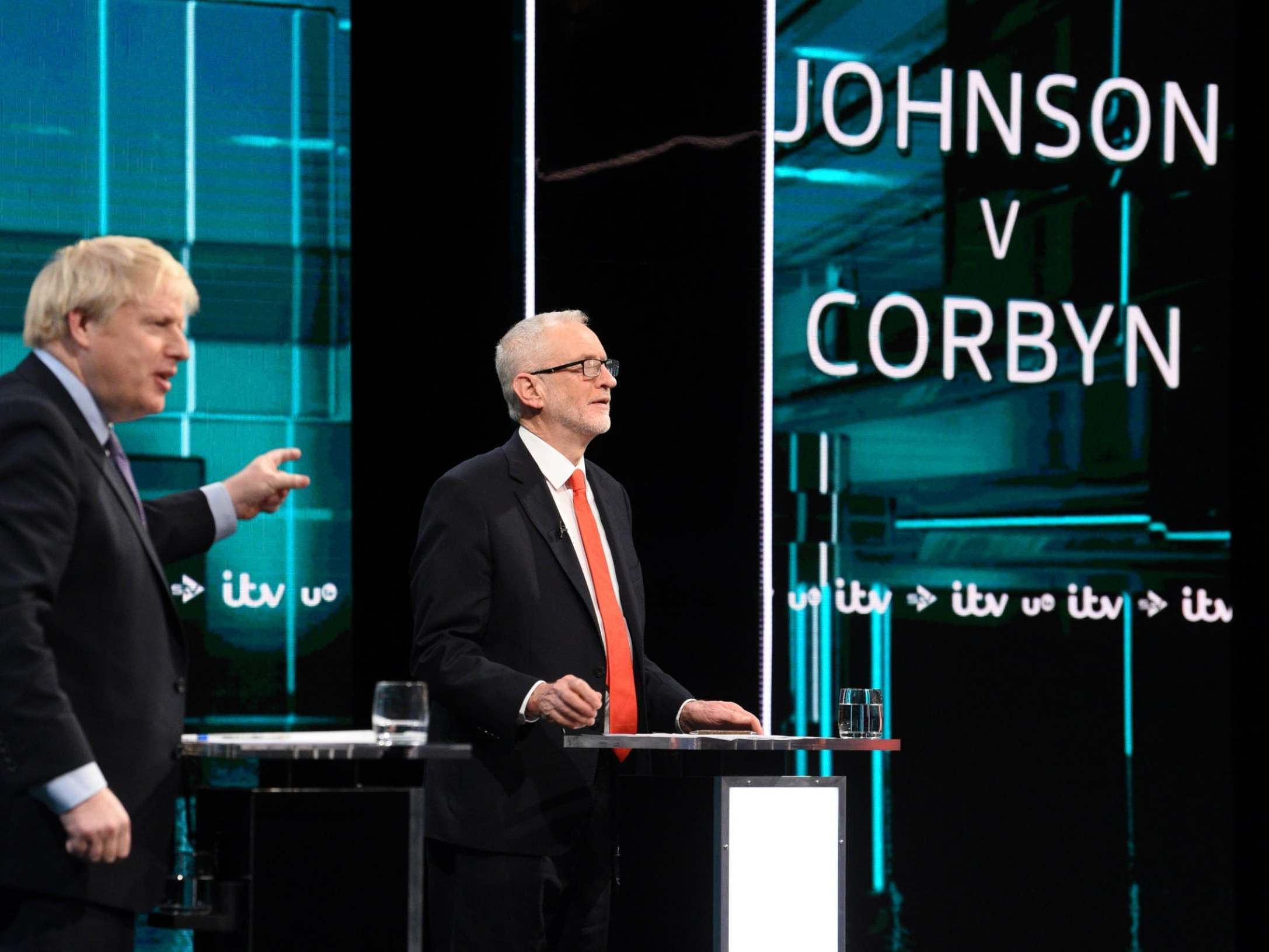General election coverage becoming increasingly 'presidential' as smaller parties are sidelined, research finds
Johnson v Corbyn TV leaders' debate 'compounded the marginalisation' of small parties, researchers find
Your support helps us to tell the story
From reproductive rights to climate change to Big Tech, The Independent is on the ground when the story is developing. Whether it's investigating the financials of Elon Musk's pro-Trump PAC or producing our latest documentary, 'The A Word', which shines a light on the American women fighting for reproductive rights, we know how important it is to parse out the facts from the messaging.
At such a critical moment in US history, we need reporters on the ground. Your donation allows us to keep sending journalists to speak to both sides of the story.
The Independent is trusted by Americans across the entire political spectrum. And unlike many other quality news outlets, we choose not to lock Americans out of our reporting and analysis with paywalls. We believe quality journalism should be available to everyone, paid for by those who can afford it.
Your support makes all the difference.Last week’s televised debate between Boris Johnson and Jeremy Corbyn has “compounded the marginalisation” of smaller parties such as the Liberal Democrats in media coverage of the general election which has become increasingly “presidential”, new research has found.
Confirming the dominance of the live TV setpieces in modern election campaigns, the Loughborough University study found that more than half of all broadcast and print election items in the following 30 hours made some reference to the ITV debate.
And researchers found an increasing focus on the leaders of the two biggest parties, who received more coverage than all other politicians combined.
“This has been a highly presidential week with a marked focus on the two major party leaders,” said the report.
“This reflects the impact of Tuesday’s debate between them – and controversially them alone – on the way the campaign has been covered.”
While TV reports were largely neutral on the outcome of the debate, newspaper articles were twice as likely to be positive as negative about Johnson’s performance and four times more likely to be negative than positive about Corbyn’s.
“As a whole, media evaluations were more negative to Corbyn than the public’s view and more positive to Johnson,” the report found.
The Liberal Democrats and Scottish National Party failed in a legal bid to ensure that leaders Jo Swinson and Nicola Sturgeon featured in the TV debate.
And the Loughborough study indicates how damaging an impact their absence had on their media profile in the following days.
Ms Swinson’s separate ITV interview shortly after the Johnson/Corbyn showdown featured in only 13 per cent of media items in the following 30 hours, and Ms Sturgeon in even fewer.
Overall in the second week of the campaign, Mr Johnson saw his prominence almost double, featuring in 40.4 per cent of news items on the election compared to 20.8 per cent in the first week. Similarly, Mr Corbyn featured in 31.3 per cent of items, compared to 18.8 per cent in week one.

The two main parties between them took 79 per cent of the press coverage in the second week of the campaign – 39.7 per cent for the Conservatives and 39.6 per cent for Labour – and 64 per cent of TV coverage – 31.8 per cent for the Conservatives and 32.1 per cent for Labour.
Each of them received double the 16 per cent of TV coverage achieved by the Lib Dems, while the Brexit Party and the SNP reached TV coverage of 6 per cent each and the Green Party 4 per cent.
The Brexit Party garnered more column inches in the press than the Lib Dems, totalling 7.5 per cent of all appearances compared to 6 per cent for Ms Swinson’s party.
Although Ms Swinson’s own visibility improved in the week of the Liberal Democrat manifesto launch, she still featured in only 7.5 per cent of media items, compared to 4.5 per cent in the first week.
Other politicians like chancellor Sajid Javid, shadow chancellor John McDonnell and Brexit Party leader Nigel Farage saw their prominence fade, while the health spokespeople for each party grabbed more column inches as the focus of the debate shifted from Brexit towards the NHS.
Brexit remained the foremost issue, but its prominence waned, featuring in 23 per cent of TV items and 21 per cent of press articles on the election, compared to 42 and 30 per cent respectively in the first week.
Out of the Brexit options, Mr Johnson’ withdrawal agreement has drawn the lion’s share of the attention, featuring in 58 per cent of stories which mentioned Brexit, followed by Remain (29 per cent) and a second referendum (22 per cent), in what researchers said was evidence of a “polarisation” in presentation of policy options.
Harder Brexit alternatives, like Mr Farage’s favoured no-deal departure were mentioned in 18 per cent of items and softer options, like Mr Corbyn’s plans to negotiate a new deal with a customs union and close single market relationship, in just 10 per cent.
The prominence of the second referendum in media coverage shows that it is this aspect of Labour’s offer, rather than the “credible” deal which the party plans to negotiate, which is receiving most attention, said researchers.
The report by Loughborough University’s Centre for Research in Communication and Culture covered the two weeks of 7 to 20 November.
Subscribe to Independent Premium to bookmark this article
Want to bookmark your favourite articles and stories to read or reference later? Start your Independent Premium subscription today.

Join our commenting forum
Join thought-provoking conversations, follow other Independent readers and see their replies
Comments